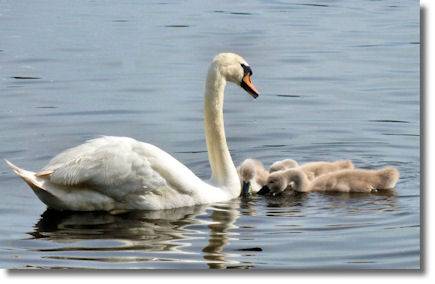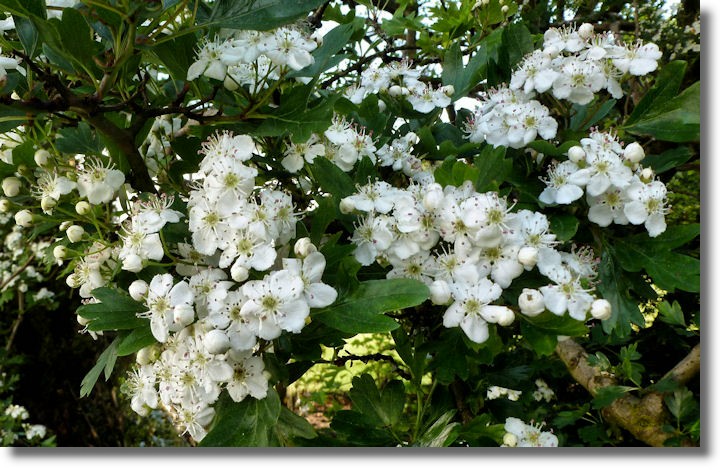Scottie's Monthly Photo Diary
- June 2012

Cygnets, Drumpellier Country Park, North Lanarkshire
Background
I never go anywhere in Scotland without my camera and I take photographs wherever I go. Sometimes I go somewhere specifically to take photographs with a view to adding another page to the Rampant Scotland site. On other occasions I just see something that makes an attractive picture or else it's another graphic to add to the library to perhaps use on a future occasion. This is a selection of the best photographs I took in June 2012 with a commentary on each one. It thus forms a pictorial diary of my travels during the month which can be shared by everyone! There's also a link to a slide show of the pictures on YouTube.
My Own Garden
The weather in June turned out to be wet, wet, wet - the UK Meteorological office reported "The mean temperature was 0.6 °C below the 1971-2000 average, making it the coolest June since 1998. It was much wetter than normal across much of southern and eastern Scotland, especially in the Borders, Lothians and Fife where 250% to 300% of the normal amount fell. Across southern and eastern Scotland, it was the wettest June on record and the number of days with rain was among the highest in the last 50 years." As a result, I was not out and about as much as usual and resorted to taking photos of the flowers in my own garden during the few dry, sunny spells. Gazania certainly needs the sunshine to open up its petals like this as it is a native of South Africa. This variety is called "Tiger Stripe".
This azalea plant was growing strongly in my garden before we moved into the house and over the years it has grown ever larger and produces a large number of blooms each spring/summer. This graphic - and a number of others this month, were taken using a camera built into my mobile phone. I started out taking photos with a digital camera for the Rampant Scotland Web site nearly 14 years ago when the best available digital equipment took photos of around 2 megapixels in size. Now my phone is capable of 8 megapixels and that isn't far behind my main camera's 13 megapixels (though that has lots of other features such as interchangeable lenses).
Hawthorn are shrubs or small trees, mostly growing to 5–15 metres (16–49 ft) tall. The branches have lots of thorns which do not seem to deter the many birds that eat the berries (sometimes known as "haws") that follow on from the usually white flowers on June. Haws are important for wildlife in winter, particularly thrushes and waxwings; these birds eat the haws and disperse the seeds in their droppings. Although sometimes called "May flower" it is unusual for hawthorn to flower in May. Even so, the old saying ""Ne'er cast a cloot til Mey's oot" conveys a warning not to shed any cloots (clothes) before the summer has fully arrived and May flowers (hawthorn blossoms) are in full bloom. This hawthorn tree is just outside the window where I work at the desktop PC and is covered in cascading blossom for several weeks at this time of year.
Although my photos of Hemerocallis usually show just one flower, the succession of blooms usually means that the "Day Lily" creates a mass of yellow trumpets. The name Hemerocallis comes from the Greek words he-mera meaning "day" and kalos meaning "beautiful". The attractive flowers typically last no more than 24 hours. The flowers of most species open in early morning and wither during the following night, possibly replaced by another one on the same flower stalk the next day.
Nemesia is a popular annual bedding plant that comes in a variety of colours. It produces a succession of flowers and so provides a long flowering season - ideal for any garden.
Rhododendron "Pink Pearl" produces its large, soft rose pink flowers in tall conical trusses from May to June. The buds are a deep true pink and open into a rosy pink blossom that quickly fades to the palest blush pink when fully open. The buds are a deep true pink and open into a rosy pink blossom that quickly fades to the palest blush pink when fully open. It's been creating a splash of colour in my back garden since 1987.
I'm not all that keen on Petunias - they tend to get eaten by insects in my garden. But I couldn't resist trying again with this upright pink variety with double petals. The variety is appropriately called "Satin Pink" and it has thrived so far, although the excessive rain does tend to batter the petals. Fortunately, it has proved to be floriferous and with frequent removal of dead flowers, more flowers soon come into bloom.
I am a bit ambivalent about Welsh Poppies. Yes, they produce many bright yellow flowers but unless the seed pods are removed before they mature, the Welsh Poppy has a weed-like tendency to self sow all over the garden and, given a chance, could take over from other plants! On the other hand, I was watching a garden bird fluttering up to a mature seed pod that hadn't been removed and succeeding in knocking out the seeds which it then proceeded to eat from the ground.
Drumpellier Country Park, North Lanarkshire
I don't know whether it has been the weather or too many successful predators (or a combination of the two), but the cygnets surviving this year have been smaller in number - with offspring numbering one, three and four so far. The trio in this group are large enough now to be likely to survive until adulthood, however. They are supervised and protected until the following spring by their parents who will pull up pond weed from the bottom of the loch to the surface for the cygnets to eat.
Here's a closer view of the three young cygnets. It doesn't take long for them to learn that pond weed is not the only food around and the rapidly learn that those two-legged creatures at the edge of the loch provide scrumptious bread to gobble up - the avian equivalent of MacDonald's fast food!
This family portrait shows the proud mum and dad escorting their young family away to another part of the loch. Don't worry about the seemingly awkward position of the foot of the cygnet on the left - swans have a habit of bending one leg out of the water like that, presumably to reduce drag, and then using just the other leg for propulsion!
Swans are not the only young birds appearing at this time of year - this mother Mallard is looking after her young family while the male Mallard plays no part in the rearing of the ducklings. Indeed, if he came near, mum mallard is likely to chase him away!
In addition to parkland, Drumpellier Country Park has a more formal garden area with a range of herbaceous and bedding plants. I rather liked the interesting colours of this large-headed poppy...
...and this purple one too!
Looks like the gardeners at Drumpellier have come to the same conclusion I did about Foxgloves - they may be "wild" flowers (in other words, weeds...) but they look good and with their self-sown seeds, return each year. So as long as they are kept under control and not allowed to grow in inappropriate areas, let's enjoy them! Foxgloves are part of the digitalis family and is also used for drug preparations, particularly one called digoxin which uses the properties of the plant which slow down the heart rate.
There is a small pond (with water lilies and frogs) in the formal garden area and the border is planted with a range of plants, depending on the time of year. The multi-colour polyanthus have been replaced this month with a range of miniature begonias. My grandfather used to grow begonias in a heated green house which (if memory serves me well) grew to the size of dinner plates. He used to win lots of prizes at the Perth Flower Show for these and his wonderful chrysanthemums!
Lupins (known as lupines in North America, I believe) are mostly herbaceous perennial plants which can grow up to nearly five feet tall. The seeds of lupins, commonly called lupin beans, were popular with the Romans, who spread the plant's cultivation throughout the Roman Empire; hence common names like lupini in Romance languages. The name 'Lupin' derives from the Latin word lupinus (meaning wolf), and was given with regard to the fact that many found that the plant has a tendency to ravage the land on which it grows. The peas, which appear after the flowering period, were also said by some to be fit only for the consumption of wolves!
This Foxglove is a bit unusual in that the colours of its trumpet-shaped flowers differ along its length instead of being one predominant colour. Foxgloves can range in colour from various purple shades to pink, white, and yellow, through various shades of light gray to purely white. The flowers can also possess various marks and coloured spots.
When I first came across this flower many years ago and looked it up in the plant identification books, I was surprised to find that it was an orchid - Dactylorhiza fuchsii or common spotted orchid. I always associate orchids with tropical forests not temperate areas such as Scotland! Not only that, it is another wild flower that can pop up in all sorts of places - I even have one that flowers in my own garden that comes up every year. It is probably the only "weed" or wild flower that I use the watering can on in dry weather!
Hogganfield Loch
The park at Hogganfield Loch in the north-west of Glasgow does not have a garden area like Drumpellier but there are nevertheless a number of flowering plants which have either been planted or have found their way to the park by natural means. There are a lot of irises such as this one growing along the edge of the loch, brightening up the view.
I think this is from a seed from an Oil Seed Rape plant which has strayed from some farmer's field to take up residence at the edge of the loch. In the farmer's field it would be one of hundreds of plants creating a sea of yellow. Here, a single plant has arrived to grow in a spot near the water's edge.
YouTube Slide Show
The photos in this page are also available as a Windows Media slide show on YouTube, with a musical accompaniment. See YouTube - Scotland Photo Diary - August 2011.If you want to read the other Diary entries going back to 2009, there is an Index page.
























